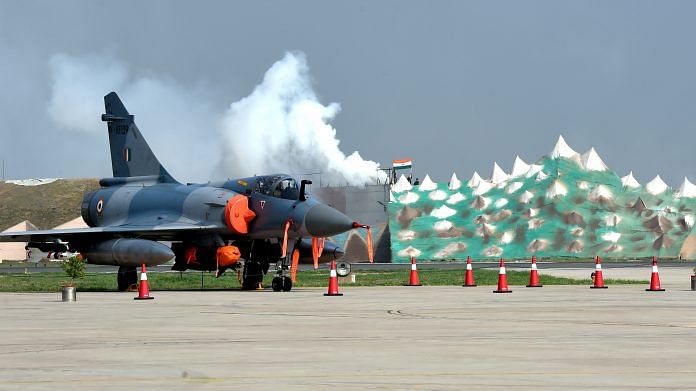Gwalior: A swarm of fighter jets flew high over ‘Tiger Hill’ this sunny Monday morning. As they crossed the landmark feature, Mirage-2000 aircraft bombed enemy camps splattered across the hill, leaving them in a thick ball of dark smoke.
Subsequent formations of fighter jets flew past the point and bombed it again.
This is the way the Indian Air Force recreated one of the key moments of the Kargil conflict at its Gwalior air base, to commemorate its success from 20 years ago. On this day in 1999, the same Mirages had bombed Tiger Hill using laser-guided precision bombs.
Days later, on 4 July 1999, India recaptured Tiger Hill, giving the IAF a moment of pride.
As the Mirages and the airmen flying them whizzed past the dummy Tiger Hill recreated in Gwalior, they received thunderous applause from the ground below, where hundreds had gathered to relive the moment with the forces.
The IAF’s task during the Kargil conflict was to help the troops on the ground. In May 1999, it launched 1,200 missions under Operation Safed Sagar — which included 578 strikes, 462 combat air patrols and escort missions, and 159 reconnaissance sorties.
Also read: The lesser-known events in India and Pakistan leading up to the Kargil war of 1999
What has changed in 20 years?
The same Mirage jets which had participated in the Kargil War also carried out the Balakot strikes in February this year, with the difference being the bombs they dropped. Back then, there were fitted with laser-guided precision bombs in a record 12 days, while during the Balakot strikes, they were armed with Israeli SPICE-2000 smart bombs.
“This was the first time the IAF had used LGBs procured from Israel,” Air Chief Marshal B.S. Dhanoa said, adding that the IAF accurately hit Tiger Hill on 24 June 1999.
Dhanoa was then the commanding officer of the 17 Squadron, while Squadron Leader Ajay Ahuja was the flight commander. Squadron Leader Ahuja was killed after his MiG-27 was shot down, and was posthumously awarded the Vir Chakra. The IAF also lost many other personnel in the attack.
Air Marshal Rajesh Kumar, Air Officer Commanding-in-Chief, Central Air Command, told the media that the attack on Muntho Dalo was the turning point of the battle.
“We brought their logistics base camp to a standstill,” he said.
The Gwalior air base is home to three squadrons of Mirage-2000s. So far, one squadron has been upgraded, extending its life by 20 years.
Also read: These 5 Indian Army, IAF heroes are the faces of the Kargil conflict




